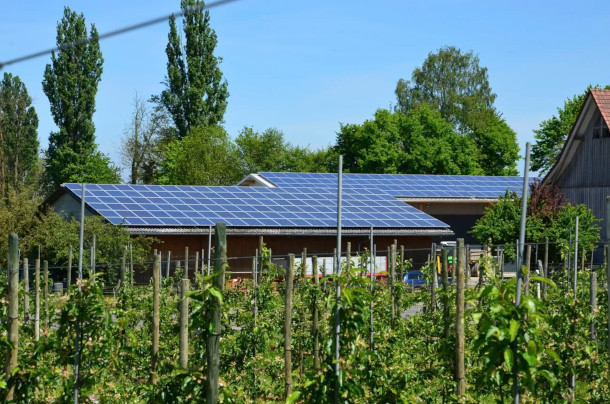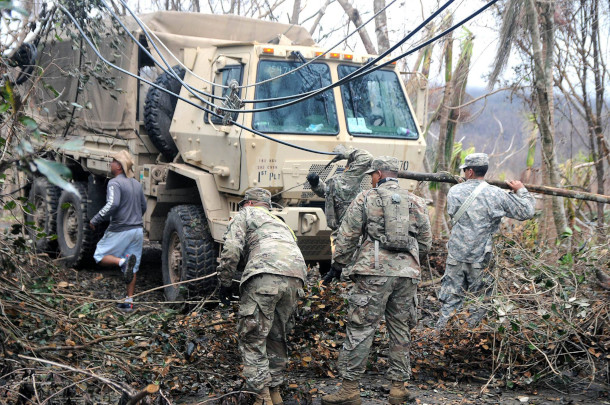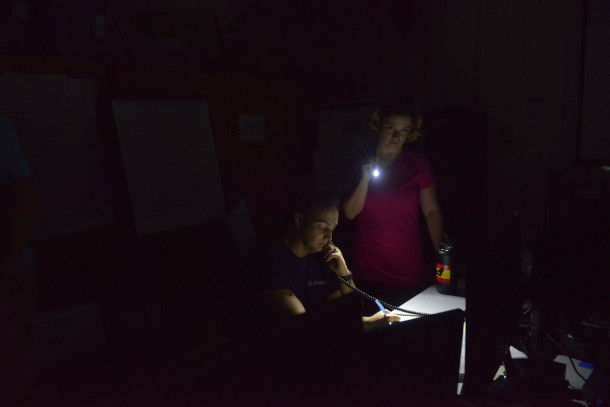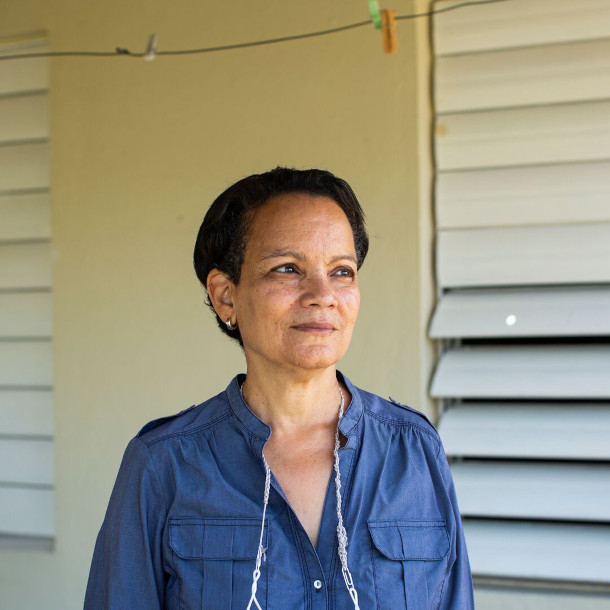Powering Puerto Rico with the Sun
Air Date: Week of October 7, 2022

Puerto Rico’s solar rooftop potential is approximately six times what the island’s demand is. (Photo: rawpixel, public domain)
For a look at part of the Hispanic experience in the United States, we turn to Puerto Rico, whose antiquated power grid has repeatedly failed catastrophically after extreme weather events including Hurricane Maria in 2017 and this year's Hurricane Fiona. Ruth Santiago, an environmental lawyer and member of the White House Environmental Justice Advisory Council, joins Host Paloma Beltran to discuss why rooftop solar offers a more reliable way to power the island.
Transcript
BELTRAN: From PRX and the Jennifer and Ted Stanley studios at the University of Massachusetts Boston this is Living on Earth, I’m Paloma Beltran.
CURWOOD: And I’m Steve Curwood
It’s now Hispanic Heritage Month and for a look at part of the Hispanic experience in the US, we’re starting with the people of Puerto Rico. Though they are US citizens, the three million plus residents of America’s largest colony don’t have equal rights.
BELTRAN: That’s right, Steve. They can’t vote in the general election for President or for voting members of Congress. So, islanders have no federal elected officials to hold Washington accountable when disasters strike. Like Hurricane Fiona this year with record rains, and Hurricane Maria in 2017 that killed thousands of people.
CURWOOD: And so far, Washington has done little to update the island’s antiquated power grid based on fossil fuels that failed catastrophically in both storms, even though the federal government already has authorized plenty of money to do so.
BELTRAN: Yes, experts like Ruth Santiago say existing funds could be tapped to meet all of Puerto Rico’s energy needs with decentralized, renewable energy sources like rooftop solar panels. Ruth Santiago is a community and environmental lawyer as well as a member of The White House Environmental Justice Advisory Council and she’s on the line. Ruth, welcome to Living on Earth!
SANTIAGO: Thank you. Thank you, Paloma. Happy to be here.
BELTRAN: Thank you. So, Ruth, how are you? Do you have electricity?
SANTIAGO: Yes, I have rooftop solar panels on my house and I have batteries and measures that allow me to keep power on. So, I had to be very careful the days of the hurricane with energy use because it was very cloudy, of course, lots of rain. But other than that, things have been back to normal, the sun is out very brightly. And panels are taking in the energy and storing in the batteries. And unfortunately my neighbors and most people in Puerto Rico don't have that. And the thing about the power outage and not having power throughout communities is that water supplies also depend many times on electric energy to power pumps, or even just generators, and many generators also failed. So that was, the generators were like the backup for the electric grid. And when the grid went out the generators were supposed to work to pump water. And that failed a lot at the water supply facilities and also at hospitals. And so it's been very dangerous for patients, for elderly, for nursing homes, that kind of thing.
Imagine what it could be like to have access to electricity that's not as vulnerable to extreme weather. Like rooftop solar with energy storage. This system in Puerto Rico survived Hurricane Maria. https://t.co/gUjliBwgaR https://t.co/FhxzcaTVlr pic.twitter.com/37KgsMEw4r
— John Farrell ☀️???????? (@johnffarrell) September 7, 2021
BELTRAN: That's horrible. And a similar situation happened during Hurricane Maria. Years ago, Hurricane Maria devastated Puerto Rico's power grid and more than 80% of the transmission and distribution system was destroyed. And in that case, repairs took years in some places. What happened during Hurricane Maria and how does it compare to what's going on right now?
SANTIAGO: We sort of need to distinguish, Hurricane Maria was almost a category five hurricane and it ripped right through the middle of southeastern Puerto Rico and sort of through the middle and out through the northwest. Hurricane Fiona, it was actually a tropical storm most of the time that it was sort of skirting the Caribbean Sea, just south of southern Puerto Rico, and only became a category one hurricane when it entered briefly through southwestern Puerto Rico. So this should not have happened, we should not have had a full blackout here. Because just imagine with every tropical storm, or category one hurricane, that has happened almost every other year here. So we haven't had this kind of outage before with this level of a storm. And it's incomprehensible. And we think it has to do with lack of vegetation management by Luma Energy and just not having the workforce to really keep up the system. And being, you know, the centralized grid, when one part goes out, often many other parts go out. And all that whole combination of things led to this very extended generalized power outage that we still have not been able to overcome.
BELTRAN: And after Hurricane Maria, the Federal Emergency Management Agency, FEMA designated around $16 billion for energy grid recovery. Where did that money go? What progress has been made on rebuilding the grid over the last five years?
SANTIAGO: Well, not a lot of it has been used. Our understanding is that FEMA has not dispersed, it's allocated and maybe obligated, and this is their terminology, some of the funds, a minimal amount of funds in comparison. But that's still within the US Treasury, right? There's one version that says FEMA has dispersed 40 million and another one that says 183 million, but in comparison to the 16 billion between FEMA and HUD together, right? That's nothing, it's not been used. And so this actually presents a good opportunity to direct that money towards a more resilient solution rather than rebuilding the centralized grid. And that is the transmission lines and towers and poles that are interconnected and that fail after each storm now.

Most of Puerto Rico’s power is generated on the southern part of the island, while most of it is used on the northern part of the island. (Photo: Staff Sgt. Wilma Orozco Fanfan, Puerto Rico Army National Guard, Flickr, CC BY 2.0)
BELTRAN: And Puerto Rico imports more than 90% of its energy supply from fossil fuels. But you think there's a better way and advocate for rooftop solar. Can you tell us more about that, please? And the potential that Puerto Rico has for solar energy?
SANTIAGO: Sure. I guess I'll start with the most recent report by the US Department of Energy through their National Renewable Energy Lab, NREL. A couple of months ago in the summer, they issued a six month progress report indicating that Puerto Rico has 20,000 megawatts worth of rooftop solar potential. And that is about six times Puerto Rico's entire energy demand. Because we've had so much sprawling residential and commercial construction here on this very small island and limited geographic area, there's been a lot of build out. And all those rooftops are suitable and can be used for placing solar panels and coupling those with batteries and providing all the energy necessary. More than enough energy.
BELTRAN: Wow, that's a tremendous amount of potential. So, Ruth, you're telling me that the entire island can be powered by the sun?
SANTIAGO: NREL says that, and previous studies have said that, in fact, more than 10 years ago, the faculty at the University of Puerto Rico at Mayagüez, they were the first to say this, they did what they call the ARET study, Achievable Renewable Energy Targets study. And they found that we had multiple times the rooftop solar potential. That was later confirmed in a couple of other studies. And the most recent is the NREL study that I cited.
BELTRAN: You'd think that with studies going as far back as 10 years ago, like you mentioned, Puerto Rico's government would be very interested in expanding the solar potential of the island.

It took 328 days for Puerto Rico to restore power to everyone who lost it after Hurricane Maria. This marked the longest blackout in U.S. history. (Photo: Petty Officer 2nd Class Jonathan Lally, U.S. Coast Guard, Flickr, CC BY-NC-ND 2.0)
SANTIAGO: Yeah, you would think so. Actually, just recently, the Governor made some statements about thinking that yeah, it might be the time for rooftop solar now. But all of his policies are directed towards doing something totally different, which is just perpetuating, you know, rebuilding this centralized grid. So generating energy far from where it's being consumed, right? And depending on these lines, and towers, and poles, and substations to move that energy long distances and in difficult terrain, mostly from southern Puerto Rico, through the central mountain range and tropical forests into the San Juan metro area, other areas in northern Puerto Rico that most of the energy demand is located. Yeah, we did hear some statements even from the Governor, but his actions, you know, just don't line up with these recent statements. Although, we did see a few weeks ago, a motion by the Puerto Rico Electric Power Authority saying that if they had any money leftover, basically from the $16 billion that they plan to use to rebuild the centralized grid, that of those $16 billion, they might use $34 million. The first is a B, the second is an M. If it was leftover, they would use it for rooftop solar in difficult to reach communities. So they've pretty much got it backwards in terms of what they're doing. But they're starting to acknowledge the resiliency value, the viability, the life-saving aspects of rooftop solar and energy storage.
BELTRAN: How much money would be required to fulfill the demand for rooftop solar across Puerto Rico?
SANTIAGO: Well, there's actually a study by an organization here called Cambio PR, and the Institute for Energy Economics and Financial Analysis, IEEFA, that they did last year, and found around $10 billion to equip households here and to reach 75% renewable energy in 15 years. Which would now be about 13 years, because that was almost two years ago.
BELTRAN: And Ruth one of the concerns that I've heard about rooftop solar is that, you know, of course, 155 mile per hour winds, which is what Maria brought, can easily rip a panel off a roof. How can people prepare for that?
SANTIAGO: Well, the companies that are selling these panels now and of course, only very high income people can afford them, but they're advertising that they can withstand up to 180 mile an hour winds, much higher than what we experienced so far, fortunately. So these panels are anchored on pretty well. So that's one thing. I mean, the real damage that these panels sometimes experience are not so much that they fly away, or they get torn off by the hurricane force winds, but that they get impacted by flying objects. And so you could lose one or a couple of panels that way. But usually you have many more than that on your rooftop, right? So you can basically eliminate the one that's been damaged from the system and keep functioning, right? And the panels are really the cheapest part of the whole system, right? The batteries and the inverters, that's the more expensive equipment that wouldn't be on a rooftop and not exposed to hurricane force winds. And another thing is there are actually groups here that have taught people how to remove panels from their rooftops and take them down during hurricanes, and then put them back up pretty quickly. They do drills that take, I think about half an hour or so. So there are a few options there to protect rooftop solar systems.

Ruth Santiago is a community and environment lawyer, as well as a member of the White House Environmental Justice Advisory Council. (Photo: Courtesy of Ruth Santiago)
BELTRAN: What would a Puerto Rico with a decentralized solar system with solar panels on every rooftop look like? How transformative would that be for the island?
SANTIAGO: Well, I think in addition to the life-saving aspects, it would have huge economic benefit, right? Because right now, we're basically exporting around a billion dollars, with the price of oil and gas now, it's probably a lot more. We're exporting a lot of money outside the Puerto Rico economy, it has no multiplier effect, no local contractors are benefiting from buying fuel oil, and you know, burning it at the plants here. So the social, the medical, the economic aspects or benefits of rooftop solar are many and cut across the whole society.
BELTRAN: What can the Biden administration do to transform Puerto Rico's grid and help build a more resilient system?
SANTIAGO: Well, so the Biden administration, and specifically FEMA, the Federal Emergency Management Agency, has already allocated this historic amount of $16 billion when you include the HUD matching share. And so that would be more than enough to equip households and businesses and institutions with rooftop solar or micro grids, right? So high rise buildings would need micro grid types of solar installations, where nearby rooftops or parking lots or, you know, adjacent areas were used to site these panels. And the FEMA funding can be used as financing for that, and transform the grid and cut the dependence on the imports and the fossil fuels and the burning and the public health impacts of burning those fossil fuels, especially to nearby communities that are overburdened by these power plants. We're actually at a point where we're awaiting a decision from FEMA on sort of what kind of environmental analysis they will do for the funding to rebuild the exact same grid, or whether they will do a more comprehensive environmental analysis like an environmental impact statement, to consider the impacts that rebuilding would have and then to consider a reasonable alternative, such as rooftop solar, distributed renewables, batteries, that kind of thing. So we're sort of awaiting that kind of decision from the Biden administration right now.
BELTRAN: Ruth Santiago is a community and environmental lawyer as well as a member of the White House Environmental Justice Advisory Council. Thank you so much for joining us, Ruth.
SANTIAGO: Thank you, Paloma.
Links
Reuters | “About 120,000 Still Without Power in Puerto Rico Days After Fiona”
More on the White House Environmental Justice Advisory Council
Living on Earth wants to hear from you!
Living on Earth
62 Calef Highway, Suite 212
Lee, NH 03861
Telephone: 617-287-4121
E-mail: comments@loe.org
Newsletter [Click here]
Donate to Living on Earth!
Living on Earth is an independent media program and relies entirely on contributions from listeners and institutions supporting public service. Please donate now to preserve an independent environmental voice.
NewsletterLiving on Earth offers a weekly delivery of the show's rundown to your mailbox. Sign up for our newsletter today!
 Sailors For The Sea: Be the change you want to sea.
Sailors For The Sea: Be the change you want to sea.
 Creating positive outcomes for future generations.
Creating positive outcomes for future generations.
 Innovating to make the world a better, more sustainable place to live. Listen to the race to 9 billion
Innovating to make the world a better, more sustainable place to live. Listen to the race to 9 billion
 The Grantham Foundation for the Protection of the Environment: Committed to protecting and improving the health of the global environment.
The Grantham Foundation for the Protection of the Environment: Committed to protecting and improving the health of the global environment.
 Contribute to Living on Earth and receive, as our gift to you, an archival print of one of Mark Seth Lender's extraordinary wildlife photographs. Follow the link to see Mark's current collection of photographs.
Contribute to Living on Earth and receive, as our gift to you, an archival print of one of Mark Seth Lender's extraordinary wildlife photographs. Follow the link to see Mark's current collection of photographs.
 Buy a signed copy of Mark Seth Lender's book Smeagull the Seagull & support Living on Earth
Buy a signed copy of Mark Seth Lender's book Smeagull the Seagull & support Living on Earth

